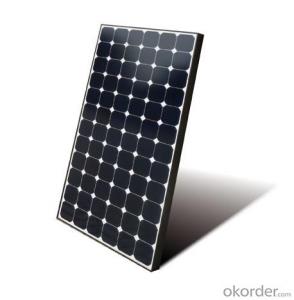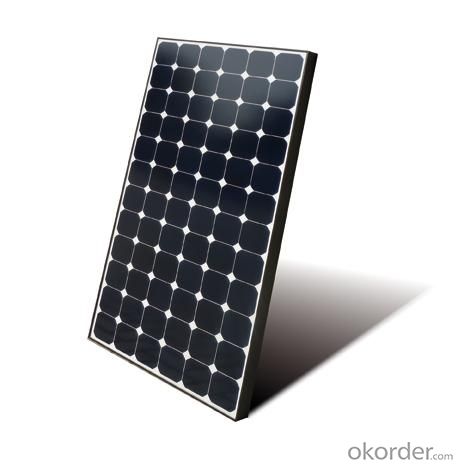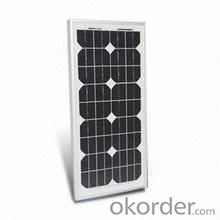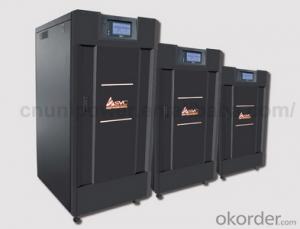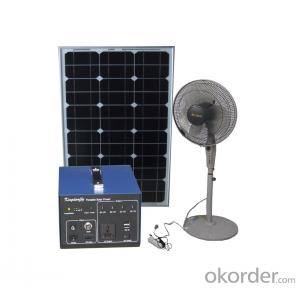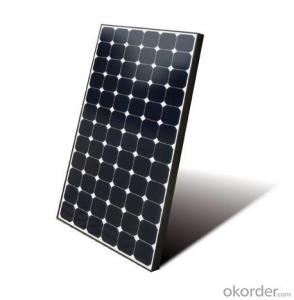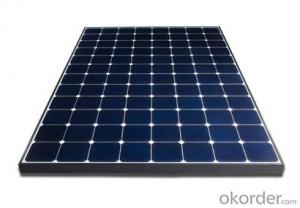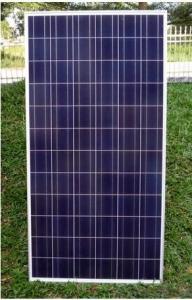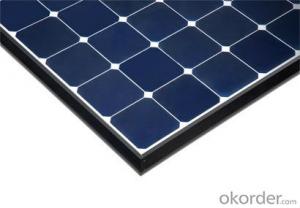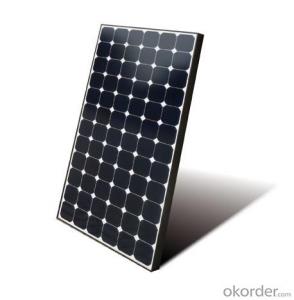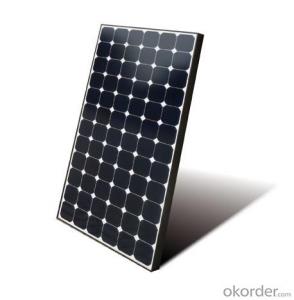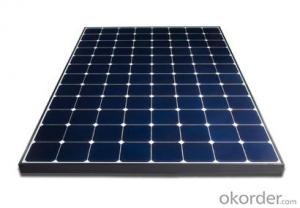Mirasol Solar Energy Systems - CNBM On-Grid System 20KW with UL, TUV, CE Certificate
- Loading Port:
- Shanghai
- Payment Terms:
- TT OR LC
- Min Order Qty:
- 100 watt
- Supply Capability:
- 1000 watt/month
OKorder Service Pledge
OKorder Financial Service
You Might Also Like
Specification
CNBM On Grid System 30KW with Certificate UL TUV CE
Product description
They range from small residential and commercial rooftop systems to large utility-scale solar power stations. Unlike stand-alone power systems, a grid-connected system rarely includes an integrated battery solution, as they are still very expensive. When conditions are right, the grid-connected PV system supplies the excess power, beyond consumption by the connected load, to the utility grid.
Connection of the photovoltaic power system can be done only through an interconnection agreement between the consumer and the utility company. The agreement details the various safety standards to be followed during the connection.[4]
Solar modules use light energy (photons) from the sun to generate electricity through the photovoltaic effect. The majority of modules use wafer-based crystalline silicon cells or thin-film cells based on cadmium telluride or silicon. The structural (load carrying) member of a module can either be the top layer or the back layer. Cells must also be protected from mechanical damage and moisture. Most solar modules are rigid, but semi-flexible ones are available, based on thin-film cells.Bypass diodes may be incorporated or used externally, in case of partial module shading, to maximize the output of module sections still illuminated.
Systems such as Net Metering and Feed-in Tariff which are offered by some system operators, can offset a customers electricity usage costs. In some locations though, grid technologies cannot cope with distributed generation feeding into the grid, so the export of surplus electricity is not possible and that surplus is earthed.
Grid-connected PV systems are comparatively easier to install as they do not require a battery system.[1][6]
Grid interconnection of photovoltaic (PV) power generation systems has the advantage of effective utilization of generated power because there are no storage losses involved.[7]
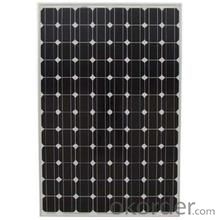
Application
Industrial
Commercial
Residential
Feature
Residential, grid-connected rooftop systems which have a capacity more than 10 kilowatts can meet the load of most consumers.[2] They can feed excess power to the grid where it is consumed by other users. The feedback is done through a meter to monitor power transferred. Photovoltaic wattage may be less than average consumption, in which case the consumer will continue to purchase grid energy, but a lesser amount than previously. If photovoltaic wattage substantially exceeds average consumption, the energy produced by the panels will be much in excess of the demand. In this case, the excess power can yield revenue by selling it to the grid. Depending on their agreement with their local grid energy company, the consumer only needs to pay the cost of electricity consumed less the value of electricity generated. This will be a negative number if more electricity is generated than consumed.[3] Additionally, in some cases, cash incentives are paid from the grid operator to the consumer.
Packaging
With carton and box
- Q: Are there any disadvantages to using solar energy systems?
- Yes, there are a few disadvantages to using solar energy systems. Firstly, the initial installation cost of solar panels and equipment can be relatively high, making it less affordable for some individuals or businesses. Additionally, solar energy generation is dependent on sunlight availability, meaning that energy production may vary depending on weather conditions or geographic location. Finally, the storage of excess energy can be challenging, as efficient and cost-effective battery storage technology is still developing. However, despite these drawbacks, the long-term benefits, such as cost savings, reduced environmental impact, and energy independence, make solar energy systems a sustainable and promising option.
- Q: Can solar energy systems be used in areas with limited access to solar energy advocacy groups?
- Yes, solar energy systems can still be used in areas with limited access to solar energy advocacy groups. While advocacy groups can provide support and resources, the installation and use of solar energy systems do not necessarily depend on their presence. With proper research and consultation with experts, individuals and communities can independently implement solar energy systems and reap the benefits of clean and sustainable energy.
- Q: How do solar energy systems impact energy resilience during natural disasters?
- Solar energy systems can significantly enhance energy resilience during natural disasters. These systems provide a reliable and sustainable source of electricity, allowing essential services such as hospitals, emergency response centers, and water treatment plants to continue functioning even when the traditional power grid is disrupted. Solar panels can generate power independently, reducing the reliance on vulnerable fuel supply chains and reducing the risk of power outages. Moreover, solar energy systems can also contribute to the overall community resilience by providing power for charging essential devices, refrigeration of medicines, and lighting in homes, thus improving the well-being and safety of affected individuals during challenging times.
- Q: Do solar energy systems require batteries for energy storage?
- No, solar energy systems do not necessarily require batteries for energy storage. While batteries can be used to store excess energy generated by solar panels for use at night or during periods of low sunlight, they are not always necessary. In grid-tied solar energy systems, the excess energy can be sent back to the utility grid and homeowners can draw energy from the grid when their solar panels are not producing enough power. This eliminates the need for batteries since the grid serves as a virtual storage system. However, for off-grid solar systems or areas with unreliable grid access, batteries are commonly used to store surplus energy for later use. Ultimately, the decision to use batteries for energy storage in a solar energy system depends on the specific requirements and circumstances of the installation.
- Q: Can solar energy systems be installed on commercial buildings?
- Yes, solar energy systems can be installed on commercial buildings. In fact, many businesses and organizations are increasingly adopting solar power as a sustainable and cost-effective alternative to traditional energy sources. Installing solar panels on commercial buildings can help reduce electricity costs, lower carbon emissions, and contribute to a greener future.
- Q: How does the quality of solar panels impact energy production?
- The quality of solar panels has a direct impact on energy production. High-quality solar panels are designed to efficiently convert sunlight into electricity, resulting in higher energy production. These panels are made with advanced technology and high-grade materials that maximize the absorption and conversion of solar energy. On the other hand, low-quality solar panels may have lower efficiency and durability. They may be made with cheaper materials and less advanced technology, leading to a lower energy production capacity. These panels may not be able to capture and convert as much sunlight into usable electricity, resulting in lower energy output. The quality of solar panels also affects their lifespan and reliability. High-quality panels are often built to withstand harsh weather conditions and have longer warranties, ensuring consistent energy production over many years. Low-quality panels may degrade faster and have shorter lifespans, leading to a decline in energy production over time. Therefore, investing in high-quality solar panels is crucial for maximizing energy production and ensuring long-term performance. Although they may be initially more expensive, the increased efficiency and durability of high-quality panels often result in higher energy savings and a faster return on investment.
- Q: Can solar energy systems be used in conjunction with wind energy systems?
- Yes, solar energy systems can be used in conjunction with wind energy systems. Both solar and wind energy are renewable sources and can complement each other in terms of their availability and energy generation patterns. Combining both systems allows for a more consistent and reliable energy supply, as solar energy is typically more abundant during the day, while wind energy is often stronger at night and during different seasons. By integrating solar and wind energy systems, we can maximize the overall energy output and enhance the sustainability of our power generation.
- Q: How efficient are solar energy systems?
- Solar energy systems are highly efficient as they convert sunlight directly into electricity or heat without any emissions or moving parts. They have an average efficiency of 15-20% for solar panels, but advanced technologies can achieve efficiencies of up to 40%. Additionally, solar systems can be optimally designed and integrated to maximize their efficiency and energy output.
- Q: Are there any risks of electrical malfunction or failure with solar energy systems?
- Yes, there are some risks of electrical malfunction or failure with solar energy systems. One of the main risks is a faulty or damaged electrical connection, which can result in a loss of power generation or even electrical fires. Additionally, extreme weather conditions such as lightning strikes or strong winds can damage the solar panels or inverters, leading to a temporary or permanent failure of the system. Another risk is the degradation of solar panels over time, which can result in decreased efficiency and eventually require replacements. Furthermore, improper installation or maintenance can lead to system failure or electrical malfunctions. It is essential to ensure that solar energy systems are installed by qualified professionals and regularly inspected and maintained to minimize these risks.
- Q: Can solar energy systems be used in powering retirement homes or assisted living facilities?
- Yes, solar energy systems can definitely be used to power retirement homes or assisted living facilities. Solar panels can be installed on the roofs or in open spaces of these facilities to capture sunlight and convert it into electricity. This renewable energy can then be used to power various amenities such as lighting, heating, cooling, and appliances, reducing their reliance on traditional power sources and lowering energy costs. Additionally, solar energy systems are environmentally friendly and sustainable, aligning with the growing trend of integrating green solutions in retirement homes and assisted living facilities.
Send your message to us
Mirasol Solar Energy Systems - CNBM On-Grid System 20KW with UL, TUV, CE Certificate
- Loading Port:
- Shanghai
- Payment Terms:
- TT OR LC
- Min Order Qty:
- 100 watt
- Supply Capability:
- 1000 watt/month
OKorder Service Pledge
OKorder Financial Service
Similar products
Hot products
Hot Searches
Related keywords
